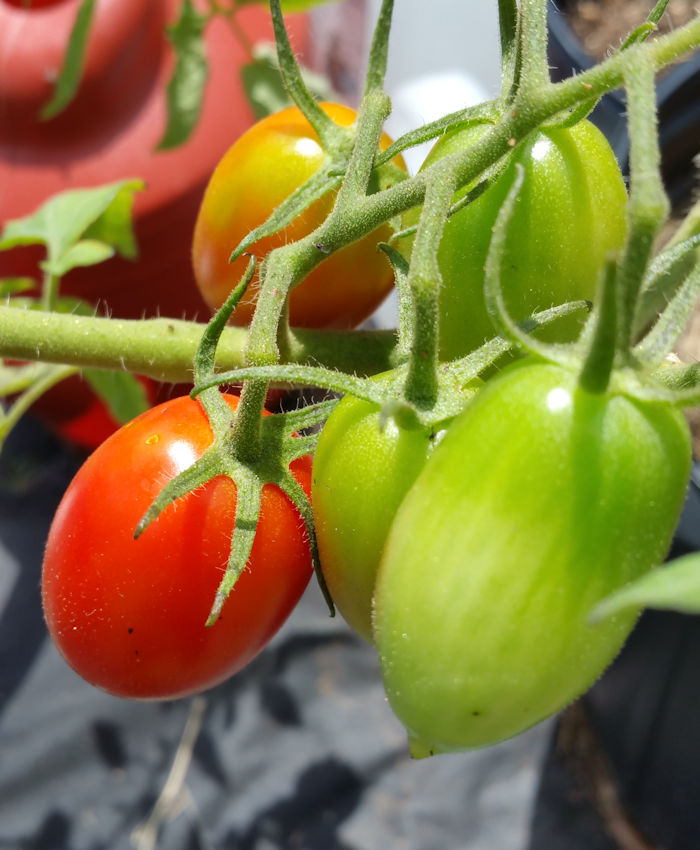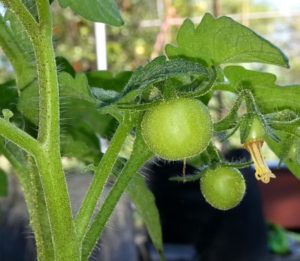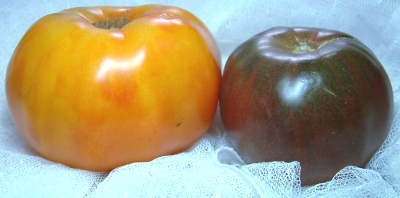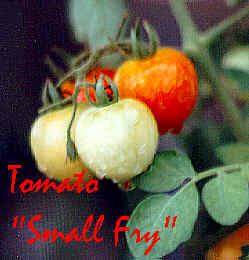tomato fun facts
Are Tomatoes Perennial?
Are tomatoes perennial? That’s a question a lot of people ask, so let’s talk about it in this post.
Annual Versus Perennial
First, let’s quickly review what perennial means, as well as what annual means, when it comes to plants.
- Annuals are those plants which live for a season. A season can be a couple of months, or perhaps up to 8 or so months. It refers to how long your growing season is, and what kind of weather your plants prefer.
- Perennials are plants which live for more than one season. If they appear to die due to (for example) frost or excessive heat, they will come back on their own once their preferred weather returns.
That’s a high-level difference between annual and perennial plants. Now let’s talk tomatoes.
Are Tomatoes Perennial?
Sadly, tomato plants are annuals. Now, that isn’t to say they can’t have a really long growing season, if they have the right environment. And if grown in a perfect environment (like a special greenhouse), it’s possible that some indeterminate tomatoes can last a year or more.
This applies more to cherry tomatoes, though, than tomatoes with larger fruits. Cherry tomato varieties are especially known for being vigorous growers and producing lots of fruits over a longer season.
Growing Indeterminate Tomato Plants as a Perennial
OK, so let’s say you have a pretty perfect environment. Not too hot, not too cold, humidity just right, plenty of sun. Plus, not exposed to tomato plant diseases and with few or no insects that love to munch on tomato plants. Oh, and plenty of room, because indeterminate tomato plants can get mighty big.
(Now you see the dilemma.)
It seems like the best environment would be a greenhouse or in an enclosed sunroom. Tomatoes like their warmth, but they don’t like high temperatures. And they don’t care for cool weather, at least not during the day. They do like moderate humidity, and good air circulation. Plus — 6 to 8 hours of direct sunshine per day, or the equivalent in bright grow lights.
If you can also control exposure to tomato diseases (many of which have to do with soil and wind-borne contaminants), and regularly patrol for tomato-loving insects, you’ve gone a long way to giving your tomato plant a longer life.
Now, let’s talk about the tomatoes themselves — because why grow the plants if you don’t plan to eat the tomatoes!
How Tomatoes Fruit on the Plant
Tomatoes set fruit starting with lower branches, and proceed upwards on the plant. Once a branch has set fruit, it’s not going to flower again once the fruit has been picked. And this means that your plant needs to grow taller in order to continue setting fruit. Alternately, it will need to bush out to continue fruiting.
If you plan to grow your tomato plants indoors under grow lights, they will need to have good light all over the plants as it grows taller and/or wider. This may mean multiple grow lights.
Growing Tomato Plants
By now you can tell that the answer to the question of “are tomatoes perennial” is that they are best grown as the annual that they are. If you plan to try to grow a tomato plant as a perennial, though, your best bet is with an indeterminate cherry tomato plant variety.
Tomato Growing Questions
Ok, tomato fun facts aside, you may have some additional tomato growing questions. Here are a few of the most common questions, with links to more detailed answers.
Before we go on to the growing questions, though, here’s a question that has plagued people for years: are tomatoes fruits or vegetables?
Botanically, tomatoes are fruits; however, as far as use, tomatoes are classed as vegetables. How come? At one point, the US government was levying a tax on imported vegetables, and tomatoes became an issue — fruit or vegetable? The final decree was “If it’s most often eaten as a part of a meal (salad or mail course), it’s a vegetable. If it’s most often eaten as a dessert, its a fruit.”
Tomato Growing Questions
Are tomatoes easy to grow? For the most part, yes! Most tomato varieties will grow and produce delicious fruits for you. If you have a short gro wing season or lots of cloudy days, however, you should stick with the early and possibly mid season fruits (stay away from the huge beefsteaks — they won’t have time to ripen). If you have a longer growing season with plenty of sunshine, you can grow almost any variety. Caveat; most tomatoes don’t like really hot and humid weather (although some varieties do OK in the heat & humidity).
wing season or lots of cloudy days, however, you should stick with the early and possibly mid season fruits (stay away from the huge beefsteaks — they won’t have time to ripen). If you have a longer growing season with plenty of sunshine, you can grow almost any variety. Caveat; most tomatoes don’t like really hot and humid weather (although some varieties do OK in the heat & humidity).
So how do I grow tomatoes? Here’s some tomato growing requirements on how to grow those great-tasting tomatoes!
Should I get plants from a garden center or start from seeds? This one will depend on your circumstances. If you are late for starting seeds, or you just don’t want to go the seed route, buying a plant from a gardening center is great. Just keep in mind that there usually isn’t a huge variety, although mostly they are varieties that will grow fine in your area. When it comes to seeds, the sky is the limit! You can grow all kinds, and experimenting can be fun. It’s also less expensive overall than buying plants. (I’ve had tomato seeds 5 and even 10 years old and still germinate.)
What kind of insects or diseases do I need to know about? Here is the lowdown on insects and diseases that could come to visit your tomatoes — and possible solutions!!
What kind of fertilizer should I use? You can use organic, chemical or a mixture of both. Check out the tomato fertilizer page for information about the different kinds.
Can I grow tomatoes is a greenhouse? Sure! The key to deciding the varieties that would be best are 1) the size of your greenhouse and 2) the warmth and sunlight your greenhouse receives. Your best bets may be determinate tomatoes, cherry tomatoes, and heart-shaped tomatoes (but any kinds are possible, depending on how big your greenhouse is).
When should I plant tomatoes? It really depends on your climate! For example, in South Florida, early Fall, late Winter and Spring are our prime tomato-growing times. For most of the country, Summer is the prime growing season. Here’s a general rule of thumb; start your seeds indoors at 4 to 6 weeks before your last expected frost — then transplant to the garden 1 week after the last expected frost (you can go a little earlier with protection).
It’s Fall, frost is coming, and my plants still have unripe tomatoes! Can I ripen these tomatoes indoors? You’ll probably be able to ripen some to even most of your tomatoes that are still on the vine; here are some tips. If you have the space, you can pull up the entire tomato plant(s) and hang them upside-down in a cool dark place. As the tomatoes ripen, pull them off the vine and enjoy! If you don’t have that kind of space, pluck the tomatoes that are farthest along, and wrap them loosely in some newspaper. Store the tomatoes in a cool dark place, in a single layer. Check the tomatoes periodically, and use those that are ripe.
Got more questions? Check out the tomato growing terms page!
Tomato Fun Facts
There are a lot of tomato questions, apart from how to actually grow them. This is more of a fun facts page, where you find out what you didn’t know that you didn’t know about tomatoes!
Tomato Fun Facts
Where Did Tomatoes Come From? The tomato is a New World addition to the diet, originating in South America in the Andes region (Chile, Ecuador, Peru). It was Central American Indians who are thought to be the first to domesticate the tomato. Tomatoes were introduced into the European diet by explorers from Mexico, in the 1500’s. Interestingly, the initial tomatoes brought back to Europe appear to have been yellow, or golden, in color — not the red that is so familiar today.
Are Tomatoes Good for You? Fresh tomatoes are loaded with Vitamins A and C. Not to mention it’s pretty much the best natural source for the antioxidant lycopene.
What Colors do Tomatoes Come In? Just about any color! There are black, white, purple, pink, orange, yellow, red, chocolate and bicolor. Blue tomatoes are now on the scene, and there are even tomatoes that stay green when they are fully ripe! And let’s not forget about the striped tomatoes — oh my!
What Shapes Do Tomatoes Come In? You’re familiar with the round and oval tomato shapes. But some others include heart-shaped, long sausage-shaped, pear-shaped and even square-shaped (okay, kind of a rounded square, but squarish nonetheless).
Which is Better – Determinate or Indeterminate? It depends on what you want to do with the tomatoes! For example, if you plan to eat some of the tomatoes fresh, but you want to preserve/can the rest, a determinate plant might be your best bet. Since it sets all its fruit at the same time, it helps streamline the canning process. If, however, you want a few tomatoes this week, a few next week, etc., an indeterminate plant might be your choice. Your ripe tomatoes are spread out over a several week period. But why not have at least one of each type, to provide constant fresh tomatoes for a variety of uses?
 What Sizes do Tomatoes Come In? The most common size the average gardener will grow is roughly 5 to 8 ounces. The tiniest I’ve ever seen were the about the size of an 8-mm bead; a fraction of an ounce. The largest tomatoes that the average gardener will grow is about 2 pounds (now that’s a LOT of tomato sandwiches)!
What Sizes do Tomatoes Come In? The most common size the average gardener will grow is roughly 5 to 8 ounces. The tiniest I’ve ever seen were the about the size of an 8-mm bead; a fraction of an ounce. The largest tomatoes that the average gardener will grow is about 2 pounds (now that’s a LOT of tomato sandwiches)!
Is it True That Tomatoes and Peppers are Related? Sure! Tomatoes and peppers are both part of the Solanaceae family, along with eggplants, tomatillos and potatoes! The tomato’s scientific name is Lycopersicon esculentum, which translates to “edible wolf-peach”. (With a name like that, no wonder the tomato was shunned as a food for many years!)
What’s the Difference Between Heirloom and Open Pollinated Tomatoes? Heirloom tomatoes are those varieties that have been around for at least since 1950, and they breed true from seed. In other words, if you save the seeds from a ripe heirloom tomato, you are likely to get a tomato that’s just like the parent. An open pollinated tomato is very similar; it just hasn’t been around as long as an heirloom. Keep this in mind — all heirlooms are open-pollinated (they breed true to seed) but not all open-pollinated tomatoes are heirloom.
What’s a Hybrid Tomato? A hybrid tomato, on the other hand, does not breed true. Since it is a deliberate cross between two different tomato plants, hybrids can produce seeds that when planted, can become more like the “grandparents” (which may or may not be a good thing!). Many times you will see “F1” after a tomato name; that is a tip-off that the tomato is a hybrid.
Why are Hybrid Seeds and Plants More Expensive? To get the hybrid seeds, suppliers must plant two different kinds of tomatoes and cross them to get the hybrid seeds. In most cases, the parent tomatoes are “trade secrets”. It’s also expensive to hand-pollinate the tomato blossoms, to assure the correct cross is made, or grow them in greenhouses, segregated spaces, etc. All this adds to the price of hybrid seeds.
What Kind is Best? It depends on what you want! In general, although vine-ripened hybrid tomatoes grown at home taste much better than their anemic cousins sold at the grocery store, it’s the heirloom and open-pollinated tomatoes that usually win the taste-tests. In addition, if you want to grow your plants organically (or at least with minimal chemical fertilizers), heirloom tomatoes have the tendency to do better. Here’s the caveat; hybrid tomatoes generally have greater disease-resistance than do heirloom. A compromise is sometimes the open-pollinated, which often have more disease-resistance, yet still have a great taste. (I grow and eat all three kinds, although I tend to grow more heirloom than anything else.) What it boils down to is what is most important to you, and how you plan to use the tomatoes.
How Many Different Kinds of Tomato Varieties are Available? In a word – lots! The Seed Savers Exchange (SSE), located in Decorah, Iowa, lists close to 2,000 tomatoes in its yearbook. However, the SSE catalogs just heirloom and open-pollinated tomatoes; don’t forget that there are still hundreds (if not more) of hybrid varieties. There are estimates that close to 10,000 varieties may exist in the world today.
How Long Will a Tomato Plant Live? Alas, tomato plants live only a season. When the frost comes, the tomato plants die. In mild regions, tomato plants can live a bit longer, but they do eventually die. Consider then annuals.
Where Can I Get Different Kinds of Tomatoes? Why not grow your own? They’re fun to grow, and you can be sure they’re vine-ripened and fresh. Also, growing your own tomatoes allows you to grow the varieties that you like — not what the grocery store buyer thinks you should like. You can buy a plant at a gardening center or better yet — grow your own from seeds. Anyway you can get them, once you’ve eaten homegrown tomatoes, no grocery store tomato will ever measure up.
